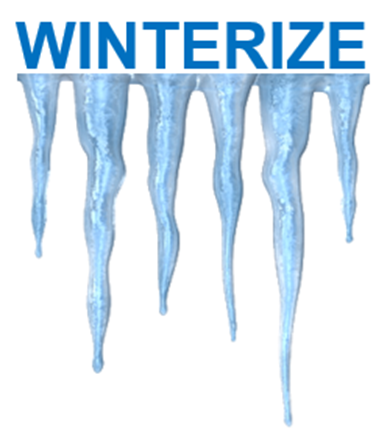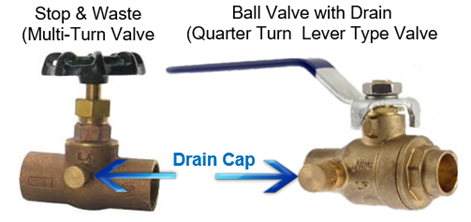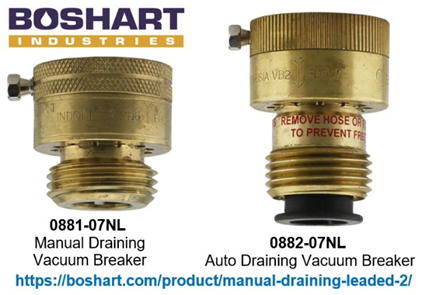How do I winterize my outdoor hose bibb faucets?
How do I winterize my outdoor hose bibb faucets?
 The old saying that, "An ounce of prevention is worth a pound of cure," is truly relevant when it comes to avoiding expensive water damage. A few minutes to prepare your outdoor faucets each fall for winter season is all it takes.
The old saying that, "An ounce of prevention is worth a pound of cure," is truly relevant when it comes to avoiding expensive water damage. A few minutes to prepare your outdoor faucets each fall for winter season is all it takes.
STEP #1
Locate all the outdoor faucets with a quick walk around the building perimeter. Remove all hoses and other devices, such as irrigation timer valves, that may be attached to the hose bibb connection.
 STEP #2
STEP #2
Locate all the shut off valves inside the home or building in the supply lines for each hose bibb faucet. The shutoff valve with a drain is normally at the ceiling of the basement just inside where the faucet supply line goes out through the wall.
These valves are designed with a drain feature and could be either a stop and waste valve or a ball valve (quarter turn, lever type). Newer construction typically has the lever-style ball valves, whereas the older system typically will have standard faucet, stop and waste type valves.
Regardless of the type, this valve has a bleed cap to allow drainage of the water out of the supply pipe and the outdoor faucet. If the shut-off valve does not have a drain feature it should be replaced with one that does. Compression type valves are a great solution for copper lines as no heat is required.
 If the outdoor hose bibb is fitted with a manual drain vacuum breaker (0881-07NL) you will need to hold the vacuum breaker open until it quits dripping. This will not be required if it has an 0882-07NL auto-draining vacuum breaker.
If the outdoor hose bibb is fitted with a manual drain vacuum breaker (0881-07NL) you will need to hold the vacuum breaker open until it quits dripping. This will not be required if it has an 0882-07NL auto-draining vacuum breaker.
STEP #3
Close all the shutoff valves, then go outside and open all the faucets to drain the water. Some of the water should drain out. However, you must go back inside to the shutoff valves and remove the bleeder/drain cap to break the air lock which will allow the remaining water to drain out of the pipe. It is a good idea to have a pail to hold under the drain/bleeder port to catch the water. When fully drained, replace the drain/bleeder cap and close the outside faucet.
What if the shut off does not have a drain feature?
Older homes often do not have the proper indoor shutoff valves for outdoor faucets. You may wish to install a valve with a drain feature or even better, replace the outdoor valve with a non-freeze or frost-free wall hydrant (a.k.a. lawn faucet) that allows you to leave the water on year-round. It is recommended to install a wall hydrant that has a built-in vacuum breaker.
If the outdoor valve is a non-freeze wall hydrant type with an aftermarket vacuum breaker, a manual type of vacuum breaker will require that you hold the drain tab to the side to allow the wall hydrant to drain. Whereas an auto-drain vacuum breaker will open and allow the hydrant to drain when the hose is removed. Again, you may want to consider upgrading to a non-freeze or frost-free wall hydrant with a built-in vacuum breaker that allows you to leave the water on year-round and will drain without any issues which add on vacuum breakers may have.

Additional Resources:
https://support.boshart.com/should-i-install-a-vacuum-breaker-on-my-faucets-hose-bibb-connection
https://support.boshart.com/what-is-the-lowest-temperature-that-wall-hydrants-are-rated-for
https://support.boshart.com/how-do-i-repair-a-leaking-or-malfunctioning-wall-hydrant
